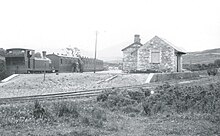This article relies largely or entirely on a
single source. (January 2016) |
Ballyliffin railway station | |||||||||||
|---|---|---|---|---|---|---|---|---|---|---|---|
| General information | |||||||||||
| Location |
Ballyliffin,
County Donegal Ireland | ||||||||||
| Coordinates | 55°16′43″N 7°23′37″W / 55.2787°N 7.3935°W | ||||||||||
| History | |||||||||||
| Opened | 1 July 1901 | ||||||||||
| Closed | 2 December 1935 | ||||||||||
| Original company | Londonderry and Lough Swilly Railway | ||||||||||
| Post-grouping | Londonderry and Lough Swilly Railway | ||||||||||
| Services | |||||||||||
| |||||||||||
| Location | |||||||||||
Ballyliffin railway station served Ballyliffin in County Donegal, Ireland. Built by the Londonderry & Lough Swilly Railway Company, the railway station was in use from 1901 to 1935.
History
The station opened on 1 July 1901 on the Londonderry and Lough Swilly Railway line from Londonderry Graving Dock to Carndonagh. The station closed for passengers on 2 December 1935. [1]

It is now privately owned.
Architecture
According to its entry in the National Inventory of Architectural Heritage (NIAH), the building is a "typical example of the railway stations along the Tooban to Carndonagh line". [2] It has a pitched slate roof, red brick chimneystacks, and yellow brick detailing. The NIAH entry states that it retains a number of "original features of interest", such as decorative clay ridge comb tiles and horned timber sash windows. [2]
References
- ^ "Ballyliffin Halt station" (PDF). Railscot - Irish Railways. Retrieved 24 May 2008.
- ^ a b "Ballyliffin Railway Station, Ballyliffin, Ballyliffin, Donegal". National Built Heritage Service. Retrieved 24 March 2024.
- Disused railway stations in County Donegal
- Railway stations opened in 1901
- Railway stations closed in 1935
- 1901 establishments in Ireland
- 1935 disestablishments in Ireland
- Railway stations in the Republic of Ireland opened in the 1900s
- Railway stations in the Republic of Ireland closed in 1935
- Irish railway station stubs

